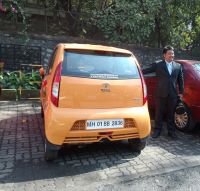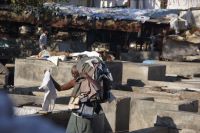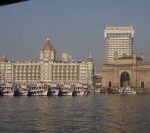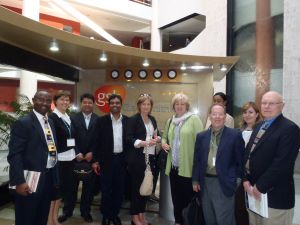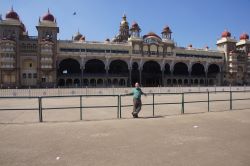Our day began with a visit to the biggest slum in the world—the Dharvarti in Mumbai. Over one million people live in an area that is 1.75 km; the businesses there total $1 b. The tour there is itself one of the businesses of the slum—at $20 a person, it is pretty steep, especially when we were told that the starting salaries in one of the shops there is about 150-200 rupees a day—that is 3-4$, though 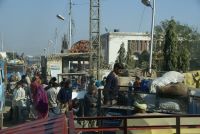 that includes room (in the shop or above), and board (there are fully functioning bakeries and restaurants in the slum). Slumdog Millionaire was (in part) filmed there, which is not a surprise given Bombay’s prominence in the film industry. If you’ve been anywhere near an Indian family, you know about Bollywood—which is even more prolific than Hollywood. And it is partly the attraction of Bollywood that draws new people to Dharvarti—as the big cities in the United States drew immigrants, and for the same reason; it was an improvement over the countryside, with a dream chance of making it out of the slum. Our guide, for example, grew up there (as did his father, when his grandfather moved there).
that includes room (in the shop or above), and board (there are fully functioning bakeries and restaurants in the slum). Slumdog Millionaire was (in part) filmed there, which is not a surprise given Bombay’s prominence in the film industry. If you’ve been anywhere near an Indian family, you know about Bollywood—which is even more prolific than Hollywood. And it is partly the attraction of Bollywood that draws new people to Dharvarti—as the big cities in the United States drew immigrants, and for the same reason; it was an improvement over the countryside, with a dream chance of making it out of the slum. Our guide, for example, grew up there (as did his father, when his grandfather moved there).
The businesses are, as you might imagine, labor intensive, and surprisingly, contribute to the “green movement “ in India. We were astonished at the amount (and variety) of recycling there; the tins that contain cooking oil are cleaned of residue (grease becomes soap), the cans repainted, and reused. Electronic goods get recycled, too, with copper stripped out and sold. There were piles of straws, the kind of small packets for ketchup—you name it, and it was probably there. One of the shops was a batik factory, making under contract for a larger firm. There was also a school, temples and mosques, and houses.
The challenge that the slum represents encompasses one of India’s many challenges. The slum sits on some of the most valuable property in Mumbai (which is itself one of the most expensive cities in the world). Trying to get locals to move requires, in this democracy, persuasion. Our guide, who I mentioned grew up there, pointed to the strong sense of community that one could not get in a high rise, and affirmed that if put to a vote, most of the residents would vote down a move to newer apartments.
Part of this trip has been in preparation for my May Term visit to India and China, and the conversation took me back to my early trips to the hutongs in China. These century-old relics of the Manchu period (pre 1911) occupied major stretches of Beijing. I thought (as a tourist) they were quaint—with a central courtyard and individual apartments surrounding it, housing, usually, several generations. Unlike the Bombay slums, the hutongs usually had no private bathrooms, and sometimes neither central heat nor electricity. The government provided the solution in China, moving residents into new housing elsewhere, turning the hutong areas into commercial districts, and leaving some for the tourist trade. One of my Chinese guides lamented many of the same changes as our guide here, but it happened in China because an autocratic government said it had to. Indians are rightfully proud of their democracy, but this is one instance where more central authority (the Indians we’ve met are appalled at the inability of their government to effect change, although political paralysis does not seem to be confined to India!) might be an improvement.
Our guide (and our national guide, a very articulate man from Delhi, with whom I hope to travel in May—I called him “guru”, or teacher) said that part of the problem with the plans to eliminate the slums so far is not only the reluctance of the slum dwellers—but the patent greed on the part of the developers. Hence, the current stalemate.
At our second visit on a rather busy day (several of our number left yesterday, and I had a car whisk me to the airport when we finished our second visit; I’m writing while waiting for the flight to Delhi at the Mumbai airport), we were at the Welspun group, a conglomerate like many Indian companies, in many industries. This one started in textiles, which is still bread-and-butter, making towels for major retailers such as Wal-mart (a sign told employees they could purchase Wimbledon towels for $5), but has diversified into energy (it owns a coal mine in Australia!), infrastructure (roads, ports and airports), and pipelines. It is a $3 b global company with 24,000 employees in foreign countries such as Arkansas, and is looking to undertake projects in the southern Sudan.
During his talk, another “aha” thought struck me about the comparison and contrasts with China. One of the faculty had asked about corporate social responsibility, and his targets were familiar—education (supporting schools in the areas it has factories),and training the underprivileged—and providing education to employees’ wives. In the other factories, and even in the slums, most of the workers we saw were men. Even the sewing shop in the slums. Any comparable factory in China would most likely have young women from the countryside manning—as it were—the factories. Another challenge for India—tapping the talent of the other half of the population!
One very entrepreneurial business our guide did point out reminded me that I’d been equally intrigued 15 years ago. It seems a local village realized that, 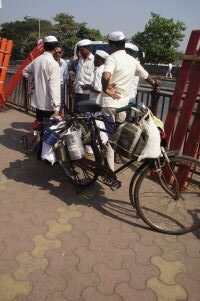 as the industry dispersed, and men spent a long time commuting to a job, they could not have a “home cooked meal.” The village developed a logistic system (I wish the airlines would let them arrange airline schedules) where they picked up a cooked meal at 9:30 or so, and delivered all the meals to the right workplace at 1 o’clock, then pick up the used dishes at 2, and return them to the employee’s house. Think of the advantages; mom could sleep in; dad could survive the train ride (he’d have at least one hand to grab onto a pole or strap, a lifesaver from what I’ve seen on the Mumbai commuter trains); and he’d get a hot meal made by his favorite cook. The distribution channel goes down to bicycles for the last mile, ending the delivery process. Our guide noted that it’s mostly the older generation. Young people, he noted, prefer (or are willing to accept) McDonald’s.
as the industry dispersed, and men spent a long time commuting to a job, they could not have a “home cooked meal.” The village developed a logistic system (I wish the airlines would let them arrange airline schedules) where they picked up a cooked meal at 9:30 or so, and delivered all the meals to the right workplace at 1 o’clock, then pick up the used dishes at 2, and return them to the employee’s house. Think of the advantages; mom could sleep in; dad could survive the train ride (he’d have at least one hand to grab onto a pole or strap, a lifesaver from what I’ve seen on the Mumbai commuter trains); and he’d get a hot meal made by his favorite cook. The distribution channel goes down to bicycles for the last mile, ending the delivery process. Our guide noted that it’s mostly the older generation. Young people, he noted, prefer (or are willing to accept) McDonald’s.
Give me a roti anytime. But I’ll have to come back to resolve at least one puzzle: if I eat something Indian and different every day for breakfast, how many years would it take before I had to repeat. On the other hand, maybe I’ll just stick to my dosa masala. Go get one (a rice pancake with a spicy potato filling), and you’ll understand why I’ll miss India.
Now if only the departure time would be sooner!
See you soon.
